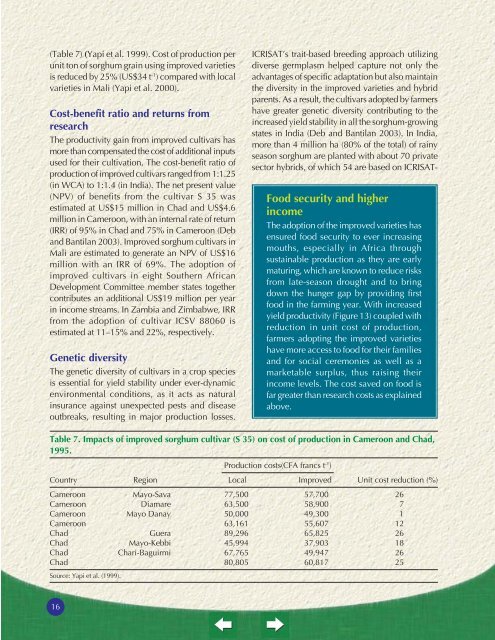Sorghum - icrisat
Sorghum - icrisat
Sorghum - icrisat
You also want an ePaper? Increase the reach of your titles
YUMPU automatically turns print PDFs into web optimized ePapers that Google loves.
(Table 7) (Yapi et al. 1999). Cost of production per<br />
unit ton of sorghum grain using improved varieties<br />
is reduced by 25% (US$34 t -1 ) compared with local<br />
varieties in Mali (Yapi et al. 2000).<br />
Cost-benefit ratio and returns from<br />
research<br />
The productivity gain from improved cultivars has<br />
more than compensated the cost of additional inputs<br />
used for their cultivation. The cost-benefit ratio of<br />
production of improved cultivars ranged from 1:1.25<br />
(in WCA) to 1:1.4 (in India). The net present value<br />
(NPV) of benefits from the cultivar S 35 was<br />
estimated at US$15 million in Chad and US$4.6<br />
million in Cameroon, with an internal rate of return<br />
(IRR) of 95% in Chad and 75% in Cameroon (Deb<br />
and Bantilan 2003). Improved sorghum cultivars in<br />
Mali are estimated to generate an NPV of US$16<br />
million with an IRR of 69%. The adoption of<br />
improved cultivars in eight Southern African<br />
Development Committee member states together<br />
contributes an additional US$19 million per year<br />
in income streams. In Zambia and Zimbabwe, IRR<br />
from the adoption of cultivar ICSV 88060 is<br />
estimated at 11–15% and 22%, respectively.<br />
Genetic diversity<br />
The genetic diversity of cultivars in a crop species<br />
is essential for yield stability under ever-dynamic<br />
environmental conditions, as it acts as natural<br />
insurance against unexpected pests and disease<br />
outbreaks, resulting in major production losses.<br />
ICRISAT’s trait-based breeding approach utilizing<br />
diverse germplasm helped capture not only the<br />
advantages of specific adaptation but also maintain<br />
the diversity in the improved varieties and hybrid<br />
parents. As a result, the cultivars adopted by farmers<br />
have greater genetic diversity contributing to the<br />
increased yield stability in all the sorghum-growing<br />
states in India (Deb and Bantilan 2003). In India,<br />
more than 4 million ha (80% of the total) of rainy<br />
season sorghum are planted with about 70 private<br />
sector hybrids, of which 54 are based on ICRISAT-<br />
Food security and higher<br />
income<br />
The adoption of the improved varieties has<br />
ensured food security to ever increasing<br />
mouths, especially in Africa through<br />
sustainable production as they are early<br />
maturing, which are known to reduce risks<br />
from late-season drought and to bring<br />
down the hunger gap by providing first<br />
food in the farming year. With increased<br />
yield productivity (Figure 13) coupled with<br />
reduction in unit cost of production,<br />
farmers adopting the improved varieties<br />
have more access to food for their families<br />
and for social ceremonies as well as a<br />
marketable surplus, thus raising their<br />
income levels. The cost saved on food is<br />
far greater than research costs as explained<br />
above.<br />
Table 7. Impacts of improved sorghum cultivar (S 35) on cost of production in Cameroon and Chad,<br />
1995.<br />
Production costs(CFA francs t -1 )<br />
Country Region Local Improved Unit cost reduction (%)<br />
Cameroon Mayo-Sava 77,500 57,700 26<br />
Cameroon Diamare 63,500 58,900 7<br />
Cameroon Mayo Danay 50,000 49,300 1<br />
Cameroon 63,161 55,607 12<br />
Chad Guera 89,296 65,825 26<br />
Chad Mayo-Kebbi 45,994 37,903 18<br />
Chad Chari-Baguirmi 67,765 49,947 26<br />
Chad 80,805 60,817 25<br />
Source: Yapi et al. (1999).<br />
16
















